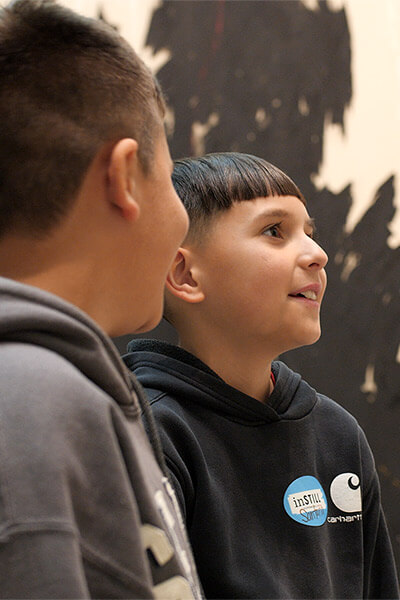By Marilyn Lindenbaum & Luisa Zamora, Clyfford Still Museum Educators
Summary:
The purpose of imaginative play is to strengthen communication skills, build sensory development, encourage good listening and trigger new ways of thinking. This creative mime can be done individually or as an interactive activity. Students will imagine they are holding a small ball of soft clay which they will transform into shapes and objects according to teacher-led descriptions and actions. Students will also respond to an abstract artwork by molding their imaginary “clay” into the shapes and images they see in the painting.
Big Idea:
- I can be creative. Creativity looks unique for each person.
Essential Questions:
- What is creativity?
- In what ways am I creative?
- What feeds my creativity?
Learning Targets:
- I can explore and play.
- I can decide what creativity means to me.
- I listen to my own creativity.
Time:
- 30-45 minutes
Materials:
- Your imagination!
- Link to Clyfford Still Museum Online Collection
- Clay, found objects, or other sculpting or building materials (optional)
Standards:
Colorado Visual Arts Standards:
- Standard 3: Invent and Discover to Create
Colorado Prepared Graduates in Visual Arts:
1. See oneself as a participant in visual art and design by experiencing, viewing or making.
10. Develop new knowledge by actively doing and making (artistic praxis), acknowledging relationships between materials, objects, ideas and lived experience.
National Visual Arts Standards:
- Creating Anchor Standard 1:
- Generate and conceptualize artistic ideas and work (applies to all grade levels)
- Responding Anchor Standard 8:
- Interpret intent and meaning in artistic work (applies to all grade levels)
CASEL SEL Framework:
- Self-Awareness: The abilities to understand one’s own emotions, thoughts, and values and how they influence behavior across contexts.
- Self-Management: The abilities to manage one’s emotions, thoughts, and behaviors effectively in different situations and to achieve goals and aspirations.
- Responsible Decision-Making: The abilities to make caring and constructive choices about personal behavior and social interactions across diverse situations.
Steps:
1. Shape Shifter (10 – 15 minutes)
- Teacher invites students to create an imaginary ball of soft dough-like material in their hands through demonstration and instruction:
- Place palms facing each other, move the hands to hold a soft “dough-like” material
- Practice stretching it into shapes, strings, balls as if it were real
- Feel the textures, slimy, sticky, boiling hot, cold and stiff, heavy weight, bouncy, feather light, stretched with holes
- Shape it into any object you would like it to be. Think about how to communicate what it is just by the way you hold it or use it
- Students may observe each other and try to guess the objects that individuals are showing
2. Looking (10 – 15 minutes)
- Invite students to look carefully at an abstract painting, noticing the shapes, lines and spaces. Pre-select with intention so that the artwork has plenty of shapes etc. to choose from
- Invite students to choose a shape/line/space in the painting, and shape their imaginary “clay” into their chosen images. You may place them together to create an imaginary group “picture” of the painting
3. Reflecting (10 – 15 minutes)
- Discussion of the process with students should include these questions:
- Could you feel the substance in your hands? Did it seem real?
- How did it feel to recreate part of the painting?
- How did everyone communicate the objects they made with their “clay”?
4. Extensions (10 – 30 minutes):
- Create the “clay” with teams of two, working together to make an object that seems real
- Ball toss – students can toss their ball to other students who mime catching and throwing to someone else. The thrower should say what the ball is made of (mud, snow, fire, energy, etc.) and who is supposed to catch it. This quick ball toss can go all around the class and is a great brain break
- Invite students to make a physical creation inspired by what they just imagined in the previous activity. Students can use clay, found materials, or what materials that are on hand.
Differentiation:
- Verbally describe the artwork
- Give the option for students to write or sketch out ideas
- Facilitate an imagination warm-up if that is a new concept for students
- Mindfulness: Invite students to look again at the artwork (virtual or in person) and pick one part of a specific artwork that shows how they are feeling. Then invite students to “sculpt” with their imaginary (or physical) clay what those feelings are. It can be more than one feeling.

